Stress Detection of Conical Frustum Windows in Submersibles Based on Polarization Imaging
Abstract
:1. Introduction
2. Materials and Methods
2.1. Material
2.2. Experiment Setup
2.3. Image Distortion Correction Method
3. Results
3.1. Characterization of Sample Changes during Pressurization and Recovery Stages by Polarization Parameters
3.2. Characterization of Elastic-Plastic Transformation of Samples Described by Polarization Parameters
3.3. Two-Layered Wave Plate Simulation
4. Discussion
4.1. Finite Element Analysis of Sample after Pressurization
4.2. Characterization Potential of Other Parameters
5. Conclusions
Author Contributions
Funding
Institutional Review Board Statement
Informed Consent Statement
Data Availability Statement
Conflicts of Interest
References
- Stachiw, J.D. Handbook of Acrylics for Submersibles, Hyperbaric Chambers, and Aquaria; Best Publishing Company: Flagstaff, AZ, USA, 2003. [Google Scholar]
- Busby, R.F. Manned Submersibles; Office of the Oceanographer of the Navy: Washington, DC, USA, 1976; pp. 55–63. [Google Scholar]
- Stachiw, J.D. Conical acrylic windows under long-term hydrostatic pressure of 10,000 psi. ASME J. Eng. Ind. 1972, 94, 1053–1059. [Google Scholar] [CrossRef]
- ASME PVHO-1. Safety Standard for Pressure Vessels for Human Occupancy; American Society of Mechanical Engineers: New York, NY, USA, 2012. [Google Scholar]
- Du, Q.H.; Hu, Y.; Cui, W.C. Safety assessment of the acrylic conical frustum viewport structure for a deep-sea manned submersible. Ships Offshore Struct. 2017, 12, 221–229. [Google Scholar] [CrossRef]
- Zhou, F.; Hou, S.; Qian, X.; Chen, Z.; Zheng, C.; Xu, F. Creep behavior and lifetime prediction of PMMA immersed in liquid scintillator. Polym. Test. 2016, 53, 323–328. [Google Scholar] [CrossRef]
- Arnold, J.C.; White, V.E. Predictive models for the creep behaviour of PMMA. Mater. Sci. Eng. A 1995, 197, 251–260. [Google Scholar] [CrossRef]
- Pranesh, S.B.; Kumar, D. Numerical and experimental study on the safety of viewport window in a deep sea manned submersible. Ships Offshore Struct. 2020, 15, 769–779. [Google Scholar] [CrossRef]
- Liu, P.F.; Li, J.X.; Wang, S.B.; Leng, J.X. Finite element analysis of viscoelastic creep behaviors of deep-sea manned submersible viewport windows. Int. J. Press. Vessel. Pip. 2020, 188, 104218. [Google Scholar] [CrossRef]
- Wang, F.; Wang, M.; Wang, W.; Yang, L.; Zhang, X. Time-dependent axial displacement of PMMA frustums designed for deep-sea manned cabin based on finite element analysis. Ships Offshore Struct. 2021, 16, 827–837. [Google Scholar] [CrossRef]
- Stachiw, J.D. Deep Submergence Spherical Shell Window Assembly with Glass or Transparent Ceramic Windows for Abyssal Depth Service. ASME J. Eng. Ind. 1975, 97, 1020–1034. [Google Scholar] [CrossRef]
- Du, Q.; Xu, D.; Liu, D. Experimental and numerical analysis on pressure effect of polymethyl methacrylate (PMMA) structure in electric-resistance strain measurement. Ships Offshore Struct. 2021, 15, 1–11. [Google Scholar] [CrossRef]
- Zhu, Y.; Liang, W.; Zhao, X.; Wang, X.; Xia, J. Strength and stability of spherical pressure hulls with different viewport structures. Int. J. Press. Vessel. Pip. 2019, 176, 103951. [Google Scholar] [CrossRef]
- Pranesh, S.B.; Sathianarayanan, D.; Ramadass, G.A.; Chandrasekaran, E.; Murugesan, M.; Rajput, N.S. Design and construction of shallow water spherical pressure hull for a manned cabin. Ships Offshore Struct. 2020, 16, 1–16. [Google Scholar] [CrossRef]
- Anwander, M.; Zagar, B.G.; Weiss, B.; Weiss, H. Noncontacting strain measurements at high temperatures by the digital laser speckle technique. Exp. Mech. 2000, 40, 98–105. [Google Scholar] [CrossRef]
- Huntley, J.M. Laser Speckle and Its Application to Strength Measurement and Crack Propagation. Ph.D. Thesis, University of Cambridge, Cambridge, UK, 1986. [Google Scholar]
- Tuchin, V.V. Polarized light interaction with tissues. J. Biomed. Opt. 2016, 21, 071114. [Google Scholar] [CrossRef] [PubMed] [Green Version]
- He, H.; He, C.; Chang, J.; Lv, D.; Wu, J.; Duan, C.; Ma, H. Monitoring microstructural variations of fresh skeletal muscle tissues by Mueller matrix imaging. J. Biophotonics 2017, 10, 664–673. [Google Scholar] [CrossRef] [PubMed]
- Shen, Y.; Sheng, W.; He, H.; Li, W.; Ma, H. Assessing distribution features of fibrous structures using Mueller matrix derived parameters: A quantitative method for breast carcinoma tissues detection and staging. In Proceedings of the Dynamics and Fluctuations in Biomedical Photonics XVII, San Francisco, CA, USA, 1–6 February 2020; Volume 11239, p. 112390F. [Google Scholar]
- Li, J.; Liao, R.; Tao, Y.; Liu, Z.; Wang, Y.; Ma, H. Evaluation for gas vesicles of sonicated cyanobacteria using polarized light scattering. Optik 2020, 216, 164835. [Google Scholar] [CrossRef]
- Wang, Y.; Liao, R.; Dai, J.; Liu, Z.; Xiong, Z.; Zhang, T.; Ma, H. Differentiation of suspended particles by polarized light scattering at 120°. Opt. Express 2018, 26, 22419–22431. [Google Scholar] [CrossRef]
- Chen, Y.; Zeng, N.; Chen, S.; Zhan, D.; He, Y.; Ma, H. Study on morphological analysis of suspended particles using single angle polarization scattering measurements. J. Quant. Spectrosc. Radiat. Transf. 2019, 224, 556–565. [Google Scholar] [CrossRef]
- Xu, Q.; Zeng, N.; Guo, W.; Guo, J.; He, Y.; Ma, H. Real time and online aerosol identification based on deep learning of multi-angle synchronous polarization scattering indexes. Opt. Express 2021, 29, 18540–18564. [Google Scholar] [CrossRef]
- Alali, S.; Vitkin, A. Polarized light imaging in biomedicine: Emerging Mueller matrix methodologies for bulk tissue assessment. J. Biomed. Opt. 2015, 20, 61104. [Google Scholar] [CrossRef]
- De Martino, A.; Kim, Y.K.; Garcia-Caurel, E.; Laude, B.; Drévillon, B. Optimized Mueller polarimeter with liquid crystals. Opt. Lett. 2003, 28, 616–618. [Google Scholar] [CrossRef] [PubMed]
- Pust, N.J.; Shaw, J.A. Dual-field imaging polarimeter using liquid crystal variable retarders. Appl. Opt. 2006, 45, 5470–5478. [Google Scholar] [CrossRef] [PubMed]
- Arteaga, O.; Freudenthal, J.; Wang, B.; Kahr, B. Mueller matrix polarimetry with four photoelastic modulators: Theory and calibration. Appl. Opt. 2012, 51, 6805–6817. [Google Scholar] [CrossRef]
- Alali, S.; Yang, T.; Vitkin, I.A. Rapid time-gated polarimetric Stokes imaging using photoelastic modulators. Opt. Lett. 2013, 38, 2997–3000. [Google Scholar] [CrossRef]
- Chang, J.; He, H.; Wang, Y.; Huang, Y.; Li, X.; He, C.; Ma, H. Division of focal plane polarimeter-based 3 × 4 Mueller matrix microscope: A potential tool for quick diagnosis of human carcinoma tissues. J. Biomed. Opt. 2016, 21, 056002. [Google Scholar] [CrossRef] [Green Version]
- Huang, T.; Meng, R.; Qi, J.; Liu, Y.; Wang, X.; Chen, Y.; Ma, H. Fast Mueller matrix microscope based on dual DoFP polarimeters. Opt. Lett. 2021, 46, 1676–1679. [Google Scholar] [CrossRef] [PubMed]
- Chang, J.; He, H.; He, C.; Ma, H. DofP polarimeter based polarization microscope for biomedical applications. In Proceedings of the Dynamics and Fluctuations in Biomedical Photonics XIII, San Francisco, CA, USA, 13–18 February 2016; Volume 9707, p. 97070W. [Google Scholar]
- Product Parameters of Jacks. Available online: http://www.yl1988.com/index.php?id=144 (accessed on 25 January 2022).
- Documentation of Imwarp. Available online: https://ww2.mathworks.cn/help/images/ref/imwarp.html?lang=en (accessed on 25 January 2022).
- He, H.; Zeng, N.; Li, D.; Liao, R.; Ma, H. Quantitative Mueller matrix polarimetry techniques for biological tissues. J. Innov. Opt. Health Sci. 2012, 5, 1250017. [Google Scholar] [CrossRef]
- Lu, S.Y.; Chipman, R.A. Interpretation of Mueller matrices based on polar decomposition. JOSA A 1996, 13, 1106–1113. [Google Scholar] [CrossRef]
- Du, E.; He, H.; Zeng, N.; Sun, M.; Guo, Y.; Wu, J.; Ma, H. Mueller matrix polarimetry for differentiating characteristic features of cancerous tissues. J. Biomed. Opt. 2014, 19, 076013. [Google Scholar] [CrossRef]
- Arteaga, O. Conversion of a polarization microscope into a mueller matrix microscope. Application to the measurement of textile fibers. Opt. Pura Apl. 2015, 48, 309. [Google Scholar]
- Tao, S.; Liu, T.; He, H.; Wu, J.; Ma, H. Distinguishing anisotropy orientations originated from scattering and birefringence of turbid media using mueller matrix derived parameters. Opt. Lett. 2018, 43, 4092. [Google Scholar]
- Li, P.; Lv, D.; He, H.; Ma, H. Separating azimuthal orientation dependence in polarization measurements of anisotropic media. Opt. Express 2018, 26, 3791–3800. [Google Scholar] [CrossRef] [PubMed]
- Chen, B.; Li, W.; He, H.; He, C.; Ma, H. Analysis and calibration of linear birefringence orientation parameters derived from Mueller matrix for multi-layered tissues. Opt. Lasers Eng. 2021, 146, 106690. [Google Scholar] [CrossRef]





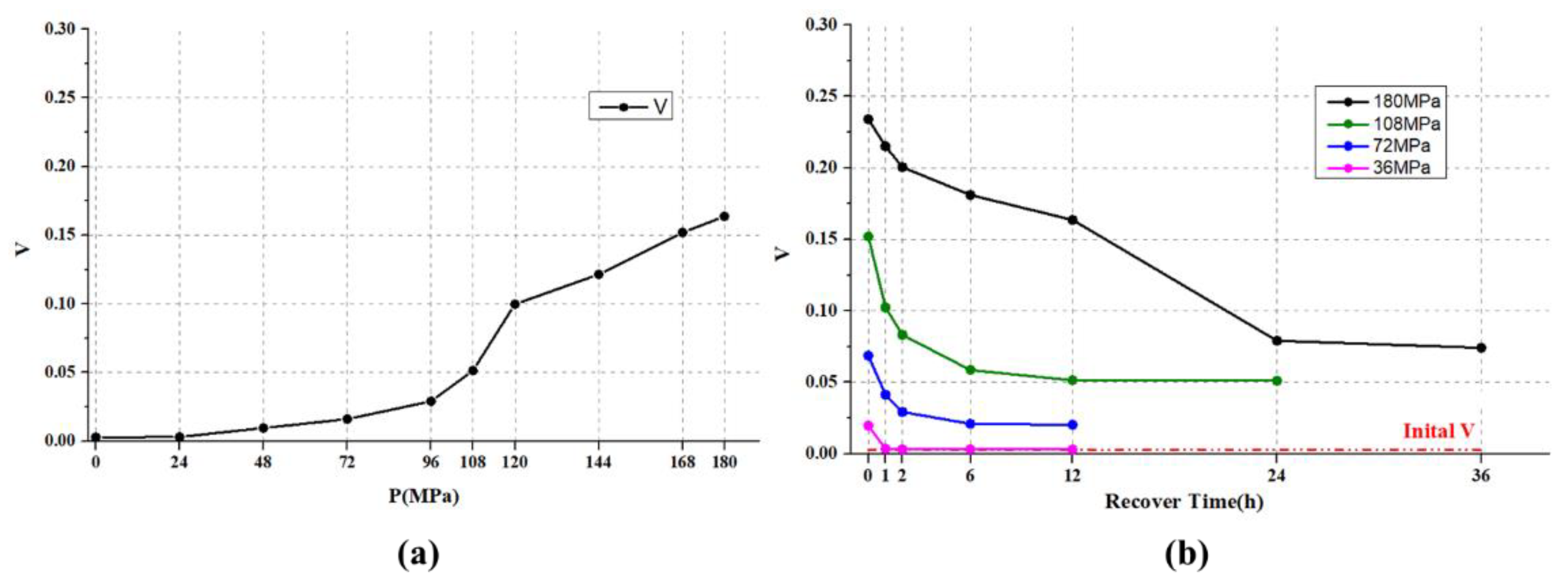
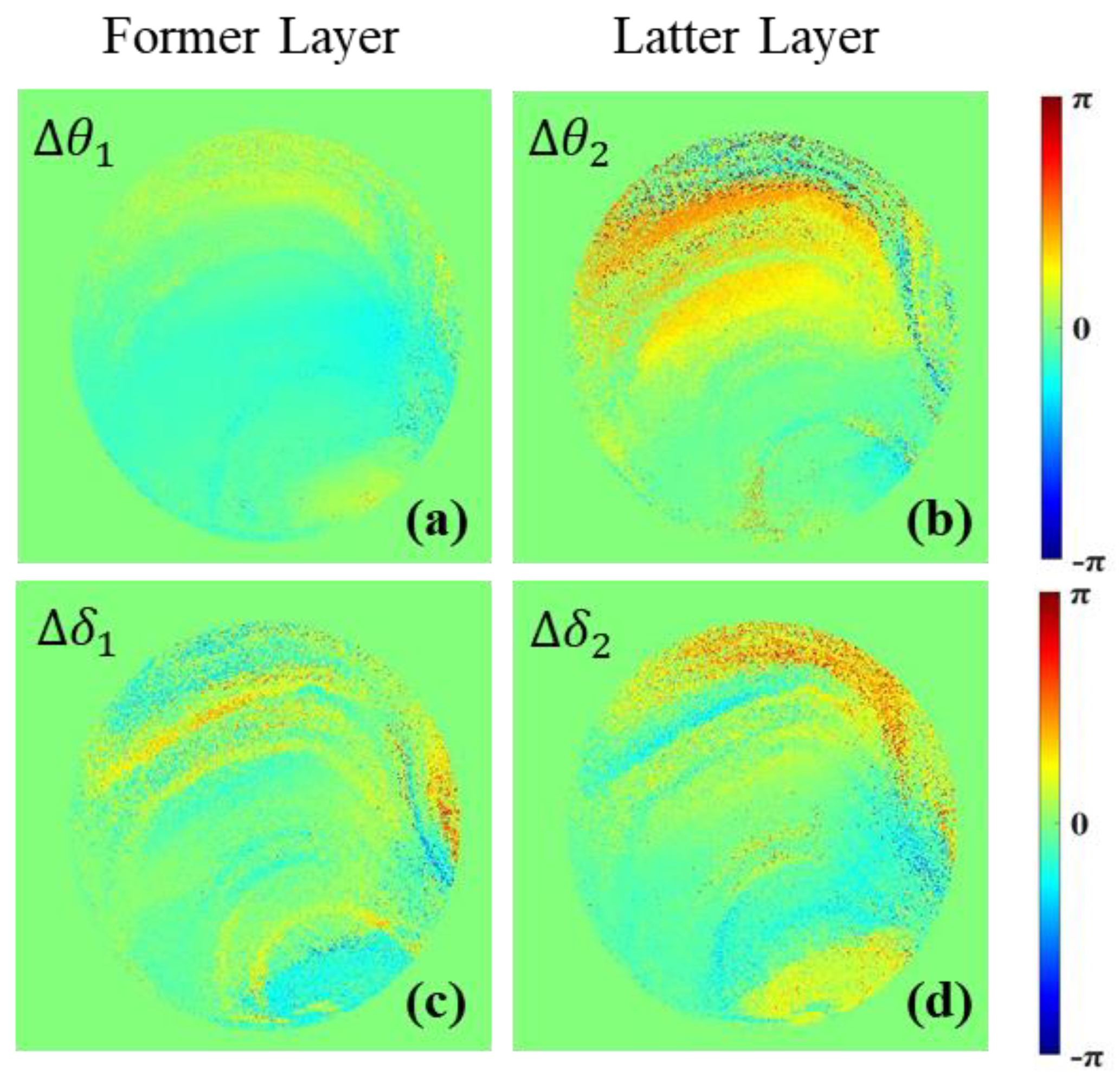
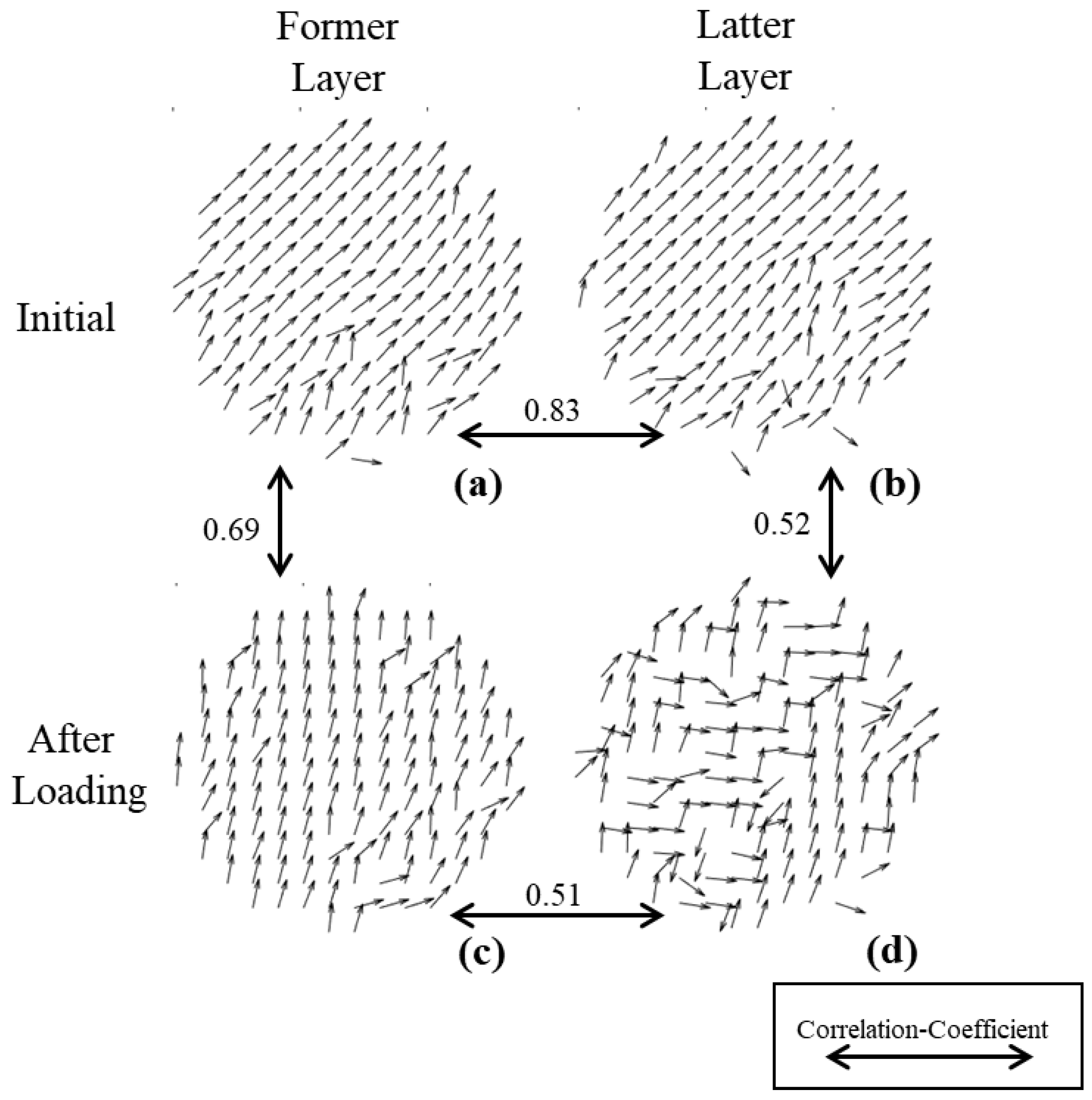
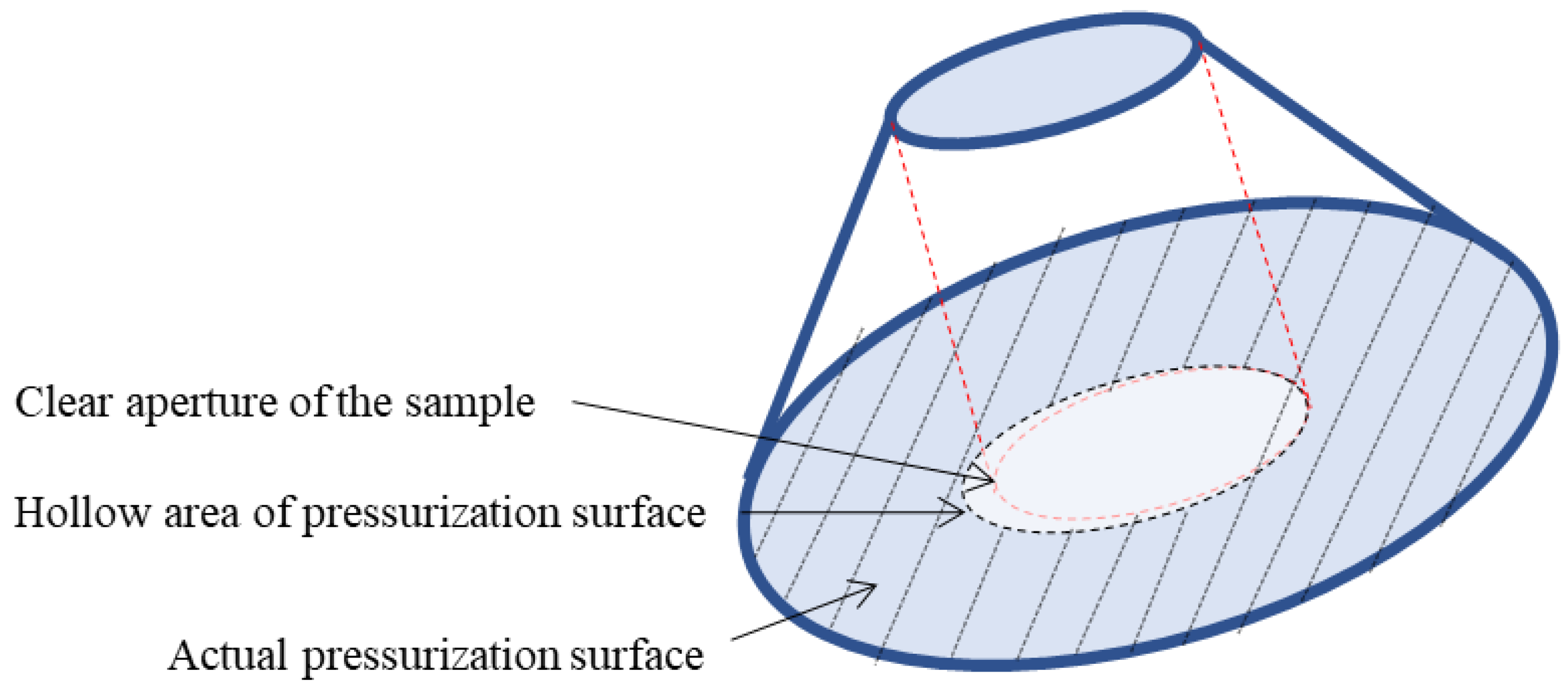
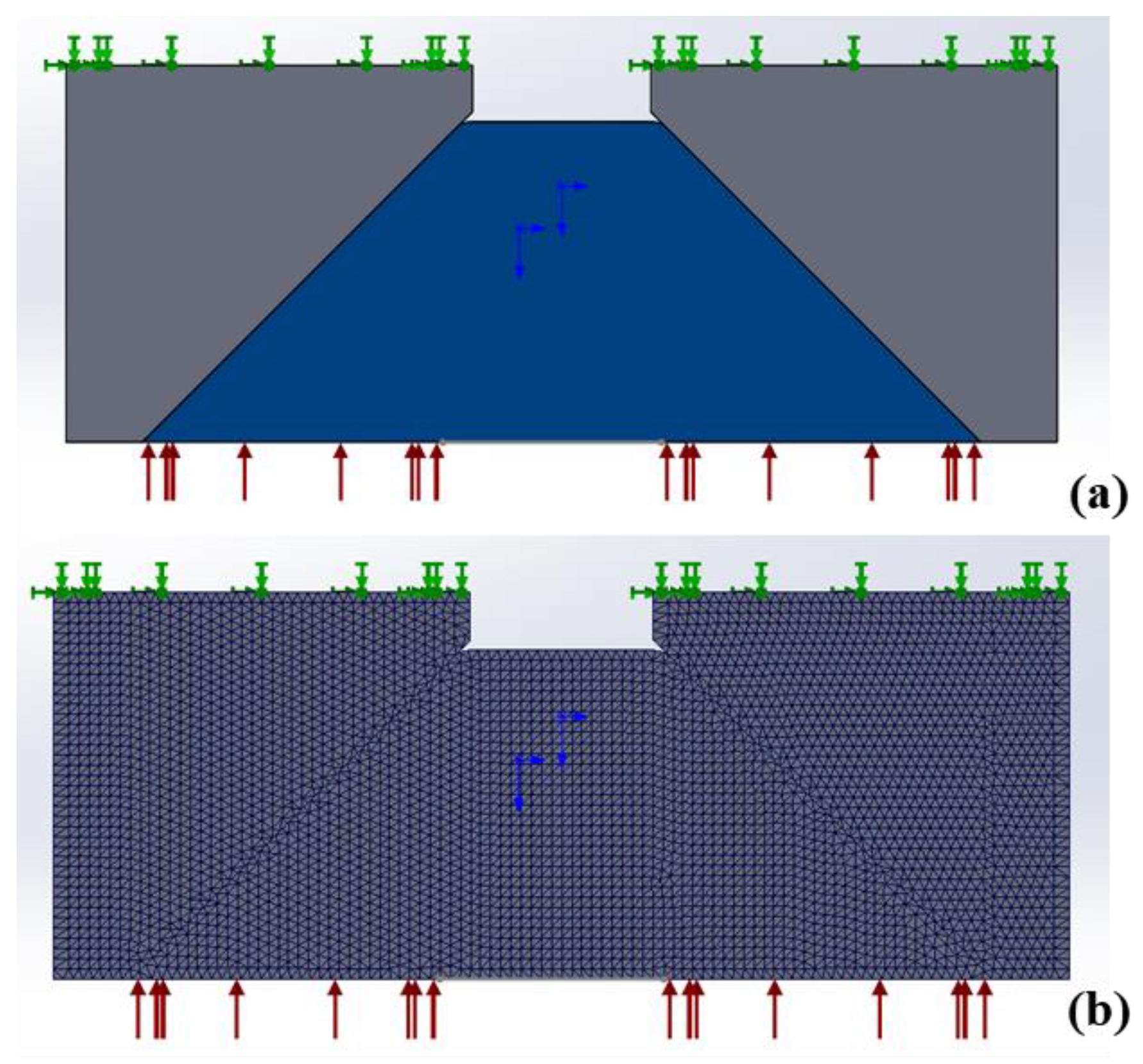


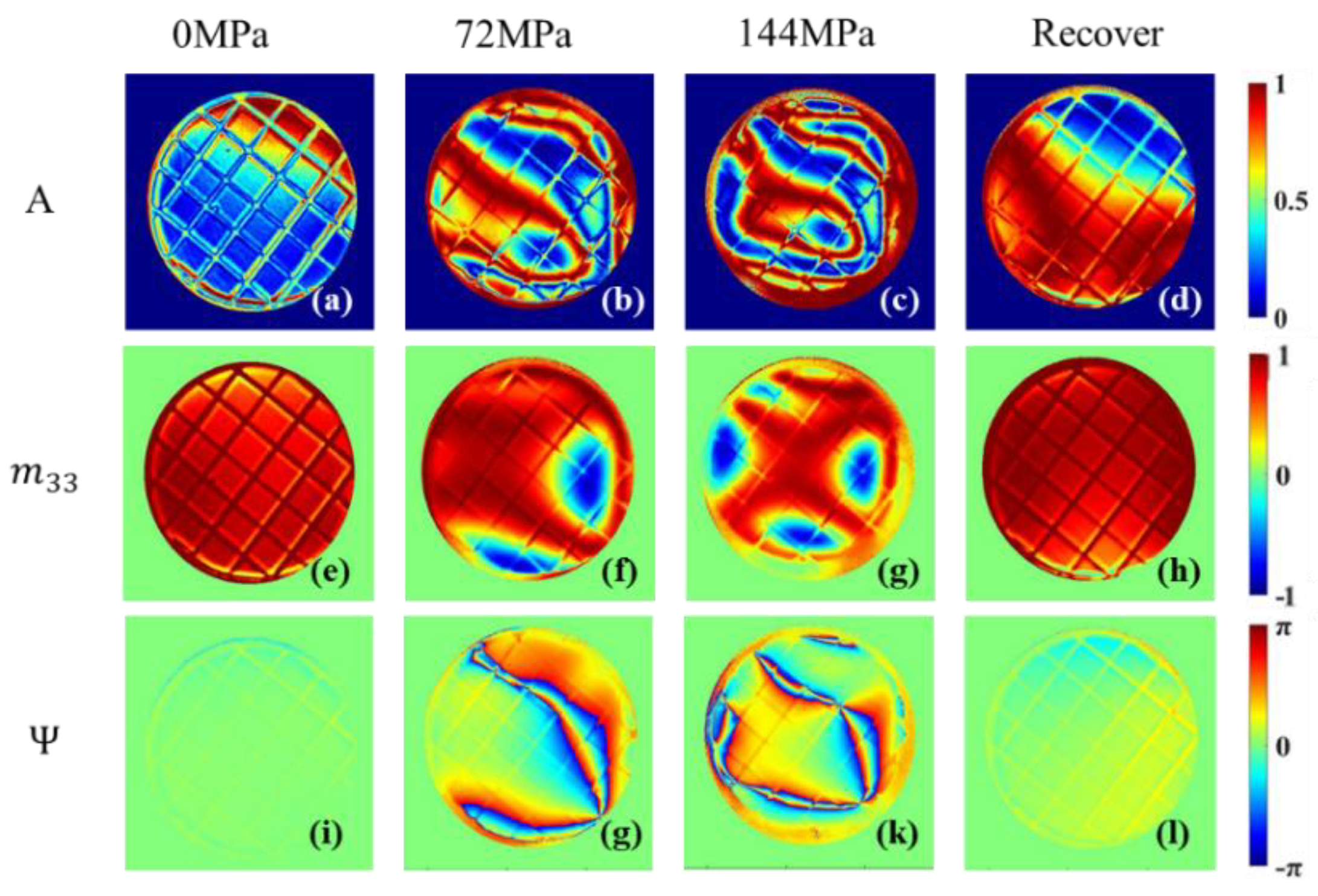
| Properties | Value |
|---|---|
| Density/(g/cm3) | 1.186 |
| Tensile Modulus/GPa | 3.13 |
| Yield Strength/MPa | 129 |
| Poisson’s ratio | 0.37 |
| Refractive index | 1.49 |
| Number | t11 | t12 | t13 | t21 | t22 | t23 | t31 | t32 | t33 |
|---|---|---|---|---|---|---|---|---|---|
| 1 | 0.8452 | −0.0135 | −1.47 × 10−5 | 0.0075 | 0.8699 | 4.45 × 10−6 | 125.6382 | 150.0923 | 1 |
| 2 | 0.8322 | −0.0158 | −2.13 × 10−5 | 0.0077 | 0.8613 | 5.34 × 10−6 | 133.1351 | 154.9269 | 1 |
| 3 | 0.8250 | −0.0209 | −2.19 × 10−5 | 0.0074 | 0.8470 | 2.20 × 10−6 | 130.6332 | 151.8865 | 1 |
| 4 | 0.8434 | −0.0099 | −1.47 × 10−5 | 0.0116 | 0.8678 | 5.71 × 10−6 | 127.6634 | 150.0143 | 1 |
| 5 | 0.8436 | −0.0126 | −1.22 × 10−5 | 0.0147 | 0.8818 | 1.16 × 10−6 | 129.1101 | 149.3359 | 1 |
| 6 | 0.8437 | −0.0072 | −1.60 × 10−5 | −0.0026 | 0.8559 | 3.04 × 10−6 | 131.3437 | 152.5151 | 1 |
| Mean ± var | 0.8389 ± 0.0083 | −0.0134 ± 0.0048 | −1.44 × 10−5 ± 7.38 × 10−6 | 0.0077 ± 0.0059 | 0.8640 ± 0.0121 | 5.39 × 10−6 ± 3.32 × 10−6 | 129.5873 ± 2.6941 | 151.4619 ± 2.0874 | 1 ± 0 |
| Properties | Value |
|---|---|
| Sample’s Density/(g/cm3) | 1.186 |
| Sample’s Tensile Modulus/MPa | 3130 |
| Sample’s Yield Strength/MPa | 121 |
| Sample’s Poisson’s ratio | 0.37 |
| Base’s Density/(g/cm3) | 7.85 |
| Base’s Tensile Modulus/MPa | 200,000 |
| Base’s Yield Strength/MPa | 551 |
| Base’s Poisson’s ratio | 0.3 |
| Friction coefficient | 0.05 |
Publisher’s Note: MDPI stays neutral with regard to jurisdictional claims in published maps and institutional affiliations. |
© 2022 by the authors. Licensee MDPI, Basel, Switzerland. This article is an open access article distributed under the terms and conditions of the Creative Commons Attribution (CC BY) license (https://creativecommons.org/licenses/by/4.0/).
Share and Cite
Li, H.; Liao, R.; Zhang, H.; Ma, G.; Guo, Z.; Tu, H.; Chen, Y.; Ma, H. Stress Detection of Conical Frustum Windows in Submersibles Based on Polarization Imaging. Sensors 2022, 22, 2282. https://doi.org/10.3390/s22062282
Li H, Liao R, Zhang H, Ma G, Guo Z, Tu H, Chen Y, Ma H. Stress Detection of Conical Frustum Windows in Submersibles Based on Polarization Imaging. Sensors. 2022; 22(6):2282. https://doi.org/10.3390/s22062282
Chicago/Turabian StyleLi, Hening, Ran Liao, Hailong Zhang, Guoliang Ma, Zhiming Guo, Haibo Tu, Yan Chen, and Hui Ma. 2022. "Stress Detection of Conical Frustum Windows in Submersibles Based on Polarization Imaging" Sensors 22, no. 6: 2282. https://doi.org/10.3390/s22062282
APA StyleLi, H., Liao, R., Zhang, H., Ma, G., Guo, Z., Tu, H., Chen, Y., & Ma, H. (2022). Stress Detection of Conical Frustum Windows in Submersibles Based on Polarization Imaging. Sensors, 22(6), 2282. https://doi.org/10.3390/s22062282







